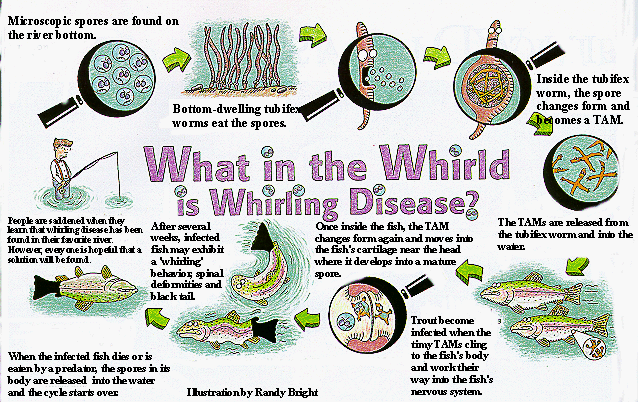
Whirling disease is a disease of salmonid fish, the family of fish that includes trout, salmon, and whitefish. The disease is caused by an invasive parasite known as Myxobolus cerebralis. The parasite penetrates the head and spinal cartilage of salmonid fish where it multiplies very rapidly, putting pressure on the organ of equilibrium. This causes the fish to swim erratically (whirl) and have difficulty feeding and avoiding predators. Other physical signs of the disease include darkened tail, twisted spine, or deformed head. In severe infections, whirling disease can cause death.
There is no known cure for fish infected with the whirling disease parasite.
The whirling disease parasite has a two-host life cycle, alternating between a small worm and a fish. Without these two hosts, the parasite cannot complete its life cycle and will die without multiplying. The worm host of the parasite is called Tubifex tubifex. This worm is very small (about 1/2-inch in length) and is very common and widespread around the world. The fish host is a salmonid fish.
As many as 10,000Tubifex tubifex worms can be found in one square yard of a muddy river bottom.
During its life cycle, the parasite takes several physical forms. Two of these are infective spore forms, called the myxospore and the triactinomyxon (TAM). The myxospore is a small, round spore that infects the Tubifex worm. Inside the worm, the myxospore changes form and become a TAM. Afterward, the TAM is released from the worm into the water column where it floats until it comes into contact with a susceptible fish. The TAM attaches to the fish’s skin and injects the parasite into the fish’s body. Once inside the fish, the parasite travels along the nervous system and moves to the head where it feeds on cartilage and begins to multiply. Inside the fish, the parasite changes form to once again become a myxospore. These spores can be shed from gills or feces or are released into the environment when the infected fish dies and begins to decompose. A single fish can be infected with many thousands, possibly millions, of disease-causing spores. Once released, the myxospores return to the soil and restart the cycle of infection.
Myxospores can remain alive for more than 20 years in the sediment.
Native to Europe, Myxobolus cerebralis was first discovered in the United States in Pennsylvania in 1956. Since then, it has been reported in numerous states and continues to spread. The presence of the parasite doesn’t always mean that a dramatic loss of fish populations will occur; the severity of the impact will vary between water bodies. The parasite does not infect humans or predators that eat infected fish; trout and salmon with whirling disease can be safely eaten.
Whirling disease causes skeletal deformation and neurological damage to salmonid fish. The “whirling” motion of infected fish makes it difficult for the fish to eat or escape predators. The mortality rate is high for salmonid fish, up to 90% of infected populations, and those that do survive are deformed by the parasites residing in their cartilage and bone.
Whirling disease is having devastating impacts on coldwater fisheries in North America.
In the United States, Myxobolus cerebralis was first detected in 1956 in Pennsylvania, having been introduced via infected trout imported from Europe. For decades whirling disease was considered a manageable problem affecting rainbow trout in hatcheries. However, in the 1990s, national attention was directed at the problem when whirling disease was linked to severe impacts on wild trout populations in Montana and Colorado. Some streams in the western United States have lost 90% of their trout as a result of the disease.
Anglers are impacted by whirling disease because it affects the health of popular sportfish. Whirling disease is most infective to Rainbow Trout and Cutthroat Trout, but can infect all salmonid species. Brown, Grayling, and Bull Trout may become infected with the parasite, but appear to be resistant to infection. Although some species may not be susceptible to whirling disease, they may still spread the disease. Carriers with no visible signs of disease are common.
Whirling disease must be confirmed by microscopic examination or other tests. If you see fish with signs of the disease in an area where whirling disease has not been reported, contact your state fisheries agency.
Stocking or natural movement of live, infected fish is the primary route by which whirling disease is spread. Whirling disease is transmitted by spores carried out by water currents, birds that have consumed infected fish, or contaminated equipment and boats. Recommended precautions that will help prevent not only the spread of whirling disease, but many other aquatic invasive species include:
In addition, each time you leave a water body: